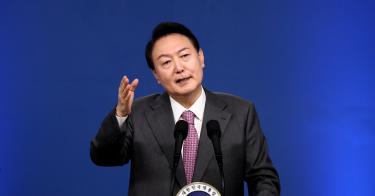To hear the Chinese tell it, Seoul has agreed to constrain its national security policies and opposes the operation of a U.S. missile defense system deployed in South Korea. The Yoon Suk Yeol administration has flatly rejected that claim.
Despite Chinese hints of coercive action, Seoul affirmed that it would not limit its efforts to defend its people against the growing North Korean nuclear and missile threats. Yoon has quickly demonstrated a resolve against Chinese intimidation that was sorely lacking in his predecessors.
The dispute lingers from the 2016 decision by the Park Geun-hye administration to allow the United States to install the Terminal High Altitude Area Defense (THAAD) system to protect against North Korean missiles. At the time, Beijing falsely claimed the THAAD system could spy deep into Chinese airspace and intercept Chinese ICBMs targeting the U.S. While the THAAD is better than any current or planned South Korean ballistic missile defense (BMD) system, it could not engage Chinese long-range missiles.
Chinese ICBM trajectories would exceed THAAD interceptor range, altitude, and speed capabilities. THAAD interceptors based in Korea are designed to attack missiles heading toward the interceptors in the terminal inbound phase, not an outbound ICBM flying away in its boost and mid-range phases. THAAD’s X-Band radar could not see or track the ICBMs since Chinese ICBM trajectories would be outside the X-band radar range.
>>> U.S., South Korea to Resume Military Exercises
Beijing retaliated to the THAAD decision by banning some South Korean products, increasing inspections to impede trade, restricting tourism, limiting distribution of South Korean movies, and encouraging domestic boycotts of South Korean goods. South Korean manufacturers lost at least $7.5 billion in economic losses and the South Korean tourism industry may have suffered $15 billion in losses.
The Moon Jae-in administration, which succeeded Park’s, eventually capitulated to Chinese pressure by accepting Beijing’s demand for “three Noes” in which Seoul promised: no additional THAAD deployments, no integration of its missile-defense system into the more comprehensive allied network, and no trilateral military alliance with Japan and the United States. After facing domestic criticism, then-Foreign Minister Kang Kyung-wha downplayed the controversy by stating that she had only reiterated current South Korean policy positions rather than formally pledging restrictions.
During last week’s meeting between Chinese Foreign Minister Wang Yi and South Korean counterpart Park Jin, Beijing asserted the Yoon administration had not only agreed to uphold the “three Noes” but also limit the operation of the existing THAAD battery deployed in 2017.
Foreign Minister Park Jin, however, contradicted Beijing’s assertions, stating that “THAAD is directly related to [South] Korea’s national security, and China must respect that.” He emphasized that the Three Noes was neither an official pledge nor an agreement. South Korea’s Defense Minister Lee Jong-sup asserted that the THAAD deployment is a “matter of national security and sovereignty. Its deployment is purely aimed at protecting our people. It would be odd if we don’t [make it work] just because of opposition from China.”
The Yoon administration’s advocacy for South Korean national security and sovereignty is a welcome change from the Moon administration’s acquiescence to stand up to Chinese intimidation. Yoon pledged to implement a principled, values-based foreign policy that would reject Moon’s fence-sitting attempts to balance between China and the United States. Instead, Yoon would strongly align with Washington and not compromise on South Korean core security interests.
That said, two of three “Noes” are non-starters. Seoul would not join a formal alliance with Japan given animosities from contentious history issues and sovereignty disputes. U.S. officials privately indicated that there would be a multi-year wait for deploying an additional THAAD battery to South Korea. Since assuming office, President Yoon has toned down campaign calls for additional THAAD deployments.
>>> Now Is Not the Time for South Korea To Go Nuclear
Seoul should integrate its Korea Air and Missile Defense system into the comprehensive U.S.-Japanese ballistic missile defense system, but has resisted to strained relations with Tokyo. Enhanced trilateral BMD cooperation is possible, however, as evidence by this month’s Pacific Dragon exercise near Hawaii where U.S., South Korean, and Japanese naval vessels practice detecting, tracking, and reporting of ballistic targets.
A more immediate task would be to grant the U.S. full-time access and fully operationalize the existing THAAD battery. Though deployed five years ago, the THAAD site has been running in emergency mode because the Moon administration dragged its feet for five years on allowing the missile battery to become fully operational, citing the necessity of an environmental impact assessment. Yoon administration officials commented that full access and operational status should be complete by the end of August.
Seoul is to be commended for its newfound backbone in dealing with China. It points to greater security for the South Korean people and convergence of vision between the U.S. and South Korea on the greatest strategic challenge facing both countries: China’s expansive geostrategic ambition.
This piece originally appeared in 19fortyfive



